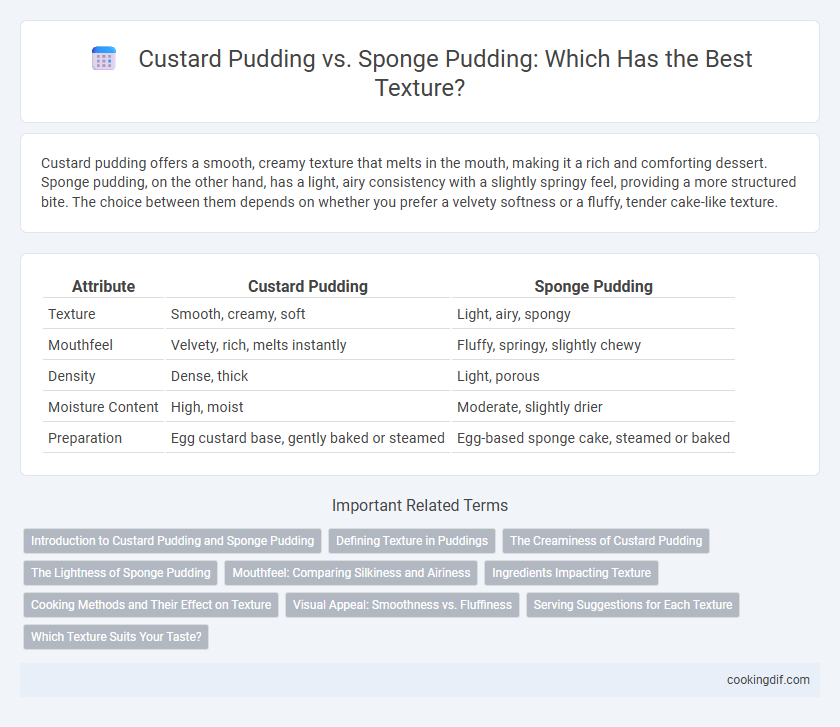Custard pudding offers a smooth, creamy texture that melts in the mouth, making it a rich and comforting dessert. Sponge pudding, on the other hand, has a light, airy consistency with a slightly springy feel, providing a more structured bite. The choice between them depends on whether you prefer a velvety softness or a fluffy, tender cake-like texture.
Table of Comparison
| Attribute | Custard Pudding | Sponge Pudding |
|---|---|---|
| Texture | Smooth, creamy, soft | Light, airy, spongy |
| Mouthfeel | Velvety, rich, melts instantly | Fluffy, springy, slightly chewy |
| Density | Dense, thick | Light, porous |
| Moisture Content | High, moist | Moderate, slightly drier |
| Preparation | Egg custard base, gently baked or steamed | Egg-based sponge cake, steamed or baked |
Introduction to Custard Pudding and Sponge Pudding
Custard pudding features a smooth, creamy texture achieved through a delicate blend of eggs, milk, and sugar, setting it apart with its rich, velvety consistency. Sponge pudding offers a light, airy texture created by incorporating flour and beaten eggs, resulting in a soft, fluffy dessert base. Both desserts highlight distinct textures that cater to different taste preferences and culinary applications.
Defining Texture in Puddings
Custard pudding features a smooth, creamy texture achieved by gently cooking egg-based mixtures until they thicken without curdling, resulting in a melt-in-the-mouth experience. Sponge pudding contrasts with its light, airy structure, created by incorporating beaten eggs or chemical leaveners that trap air bubbles, giving a soft, fluffy bite. The defining texture in puddings hinges on ingredient ratios and cooking methods, where custard's silkiness comes from controlled coagulation, and sponge's springiness relies on aeration and steam expansion.
The Creaminess of Custard Pudding
Custard pudding boasts a rich creaminess attributed to its smooth, silky texture created by slowly cooked eggs and milk, resulting in a melt-in-the-mouth experience. In contrast, sponge pudding offers a light, airy texture with a delicate crumb structure, lacking the dense creaminess of custard. The creamy consistency of custard pudding makes it a preferred choice for those seeking a luxurious and indulgent dessert.
The Lightness of Sponge Pudding
Sponge pudding offers a uniquely airy and fluffy texture due to its whipped eggs and flour base, creating a lightness that contrasts sharply with the dense, creamy consistency of custard pudding. While custard pudding relies on a smooth, velvety texture from its egg and milk mixture, sponge pudding highlights a delicate, spongy structure that melts softly in the mouth. This lightness makes sponge pudding an ideal choice for those seeking a dessert with both softness and subtle springiness.
Mouthfeel: Comparing Silkiness and Airiness
Custard pudding offers a smooth, velvety mouthfeel characterized by its rich silkiness that melts in the mouth, while sponge pudding provides a light, airy texture with delicate, springy bubbles that create a soft bite. The dense creaminess of custard contrasts with the fluffy structure of sponge, appealing to different sensory preferences depending on the desired indulgence. Mouthfeel differences are key to distinguishing these desserts, with custard focusing on creamy smoothness and sponge emphasizing lightness and sponge resilience.
Ingredients Impacting Texture
Custard pudding relies heavily on eggs and milk, where the proteins in eggs coagulate during cooking to create a smooth, creamy texture, while the high milk content adds silkiness. Sponge pudding incorporates flour, eggs, sugar, and leavening agents that create a light, airy crumb structure with a soft yet spongy mouthfeel. The starches and proteins in flour form a network that traps air bubbles, making sponge pudding distinctly fluffier compared to the dense, velvety texture of custard pudding.
Cooking Methods and Their Effect on Texture
Custard pudding achieves a creamy, smooth texture through gentle baking or steaming, which allows the eggs to set without curdling. Sponge pudding relies on a batter leavened with air or chemical agents, steamed to create a light, fluffy, and porous texture. The choice of cooking method--slow, controlled heat for custard versus vigorous steaming for sponge--directly influences the final mouthfeel and density of each pudding type.
Visual Appeal: Smoothness vs. Fluffiness
Custard pudding boasts a visually smooth and glossy surface that highlights its creamy, dense texture, appealing to those who enjoy a silky mouthfeel. In contrast, sponge pudding presents a fluffy, airy appearance with a light, porous structure that visually signals softness and sponginess. The distinct textures are emphasized by custard pudding's uniform, sleek finish versus the sponge pudding's textured, springy form, influencing consumer preference based on visual appeal and expected tactile sensation.
Serving Suggestions for Each Texture
Custard pudding, with its smooth and creamy texture, pairs excellently with fresh berries or a drizzle of caramel sauce to enhance its rich flavor. Sponge pudding offers a light, airy texture that complements warm sauces like treacle or custard, making it ideal for cozy, comforting desserts. Serving custard pudding chilled emphasizes its delicate consistency, while sponge pudding is best enjoyed warm to highlight its soft, fluffy crumb.
Which Texture Suits Your Taste?
Custard pudding offers a smooth, creamy texture that melts gently on the tongue, ideal for those who enjoy a rich and velvety dessert experience. Sponge pudding provides a light, airy texture with a slight springiness, perfect for individuals who prefer a more structured bite and subtle chewiness. Choosing between custard and sponge pudding depends on whether you favor silky softness or a tender, spongy consistency in your dessert.
Custard pudding vs sponge pudding for texture Infographic

 cookingdif.com
cookingdif.com